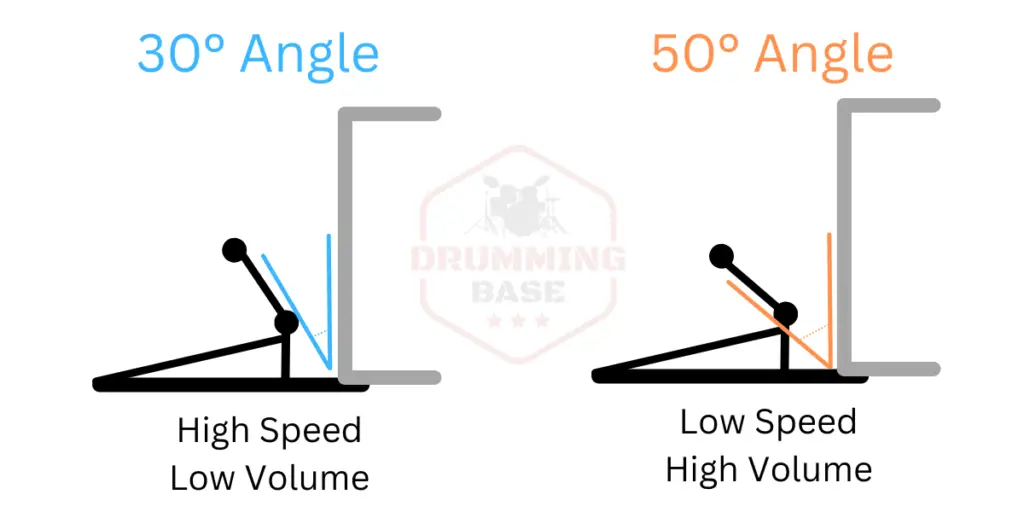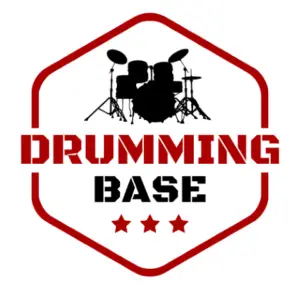Setting up your kick drum pedal correctly is really important as it affects both the feel and sound of your drum. In this article I’ll take you through what you need to know about the beater height and angle to get the best positioning for you.
Here’s the quick answer…
The bass drum pedal should be adjusted so that the beater aligns close to the centre of the bass drum. The angle of the beater to the bass drum head at rest should be roughly 40-45°. To increase the volume of the drum the angle can be increased, or to make the pedal faster, the angle can be decreased.
Beater Height
Ideally, the beater should hit the bass drum close to the centre of the drum head. This will produce the punchiest tone.
There’s a bit of a debate as to whether perfectly centre, or off centre is the best position for the beater to strike the head. Some argue that the centre sounds a bit dead, others argue that it produces the most powerful sound with more low-end. It’s best to experiment and decide for yourself.
It’s okay if the beater is slightly higher or lower than central though, the sound difference will barely be noticeable (if at all). You should always look to prioritise feel when it comes to the bass drum pedal placement.
If you’re playing on say an 18″ kick drum, it’s likely that the beater will hit the drum head slightly above the centre. Conversely, if you are using a 22″ kick drum, the beater will probably hit the head slightly below centre since the drum is larger.
This is fine and as long as it feels comfortable. Many drummers also place their bass drums on risers which will affect the height that the beater strikes it. You can also adjust the length of the beater shaft on some pedals which again, will impact the height.
However, it’s worth bearing in mind that this will have an impact on the feel of the pedal. A longer beater shaft feels heavier, so more powerful, but also more sluggish and requires more force to operate.

Beater Angle
The angle of the beater affects two things:
- Volume of the bass drum
- Speed of the beater
Let’s consider an example.
If the beater angle is 50°, then the beater has a longer distance to travel to the drum head. This allows it to gather more speed, resulting in a louder sound when it hits the kick drum. However, it also means that it will take longer for the impact to occur, so feels less responsive.
A 30° beater angle on the other hand, will sound quieter (as there is less distance for the beater to travel), but also much faster and less sluggish.
As a general rule, the beater angle should be between 30° and 50°. Within this range, it’s all down to personal preference. If you prefer a fast response, go with a smaller angle, but if you want more volume, go with a larger angle.
Remember that you can also adjust the spring tension to help compensate. If you need the beater to rebound faster but still want a larger angle to get more volume, consider increasing the spring tension. However, keep in mind that this will require more physical effort.
Check out this article comparing high and low bass drum pedal spring tension to learn more.

Beater Impact Angle
The other angle we need to address here is the angle at which the beater head is in relation to the batter head on impact.
Ideally, the beater head will hit the batter head completely flush. Many drummers argue that this feels and sounds the best.
If the drum is parallel to the ground then the beater will usually hit the head at an angle which is over 90 degrees. Hence, many drummers like to raise the drum to make the beater hit it at a flat angle. However, some drummers aren’t a fan of this method as it can put the hoop under some pressure.
To counteract the issue you can get a beater with an adjustable angle so you get get it to hit the head perfectly, but without angling the front of your kick drum upwards.
Check out this article debating whether the kick drum should be raised or not to learn more.

